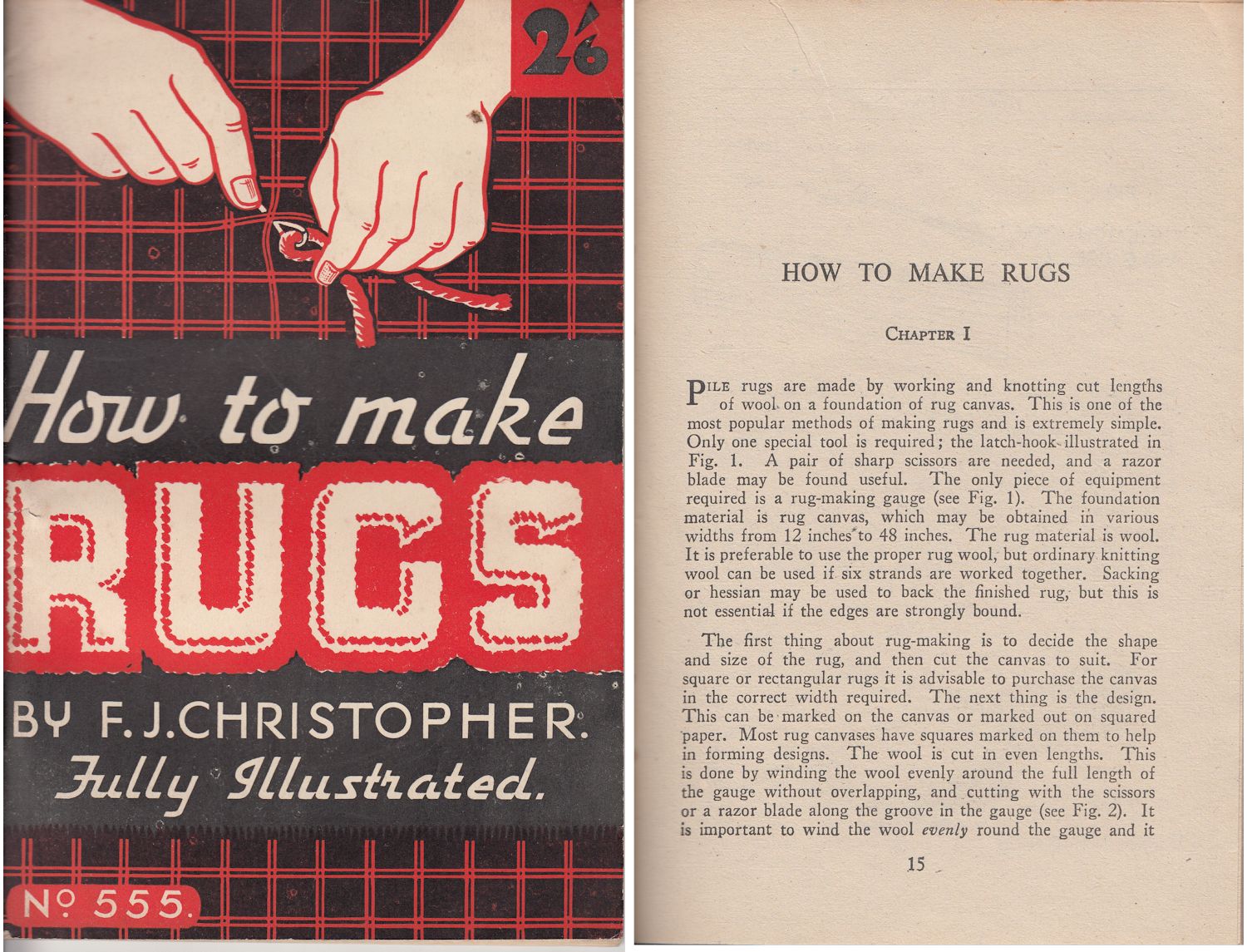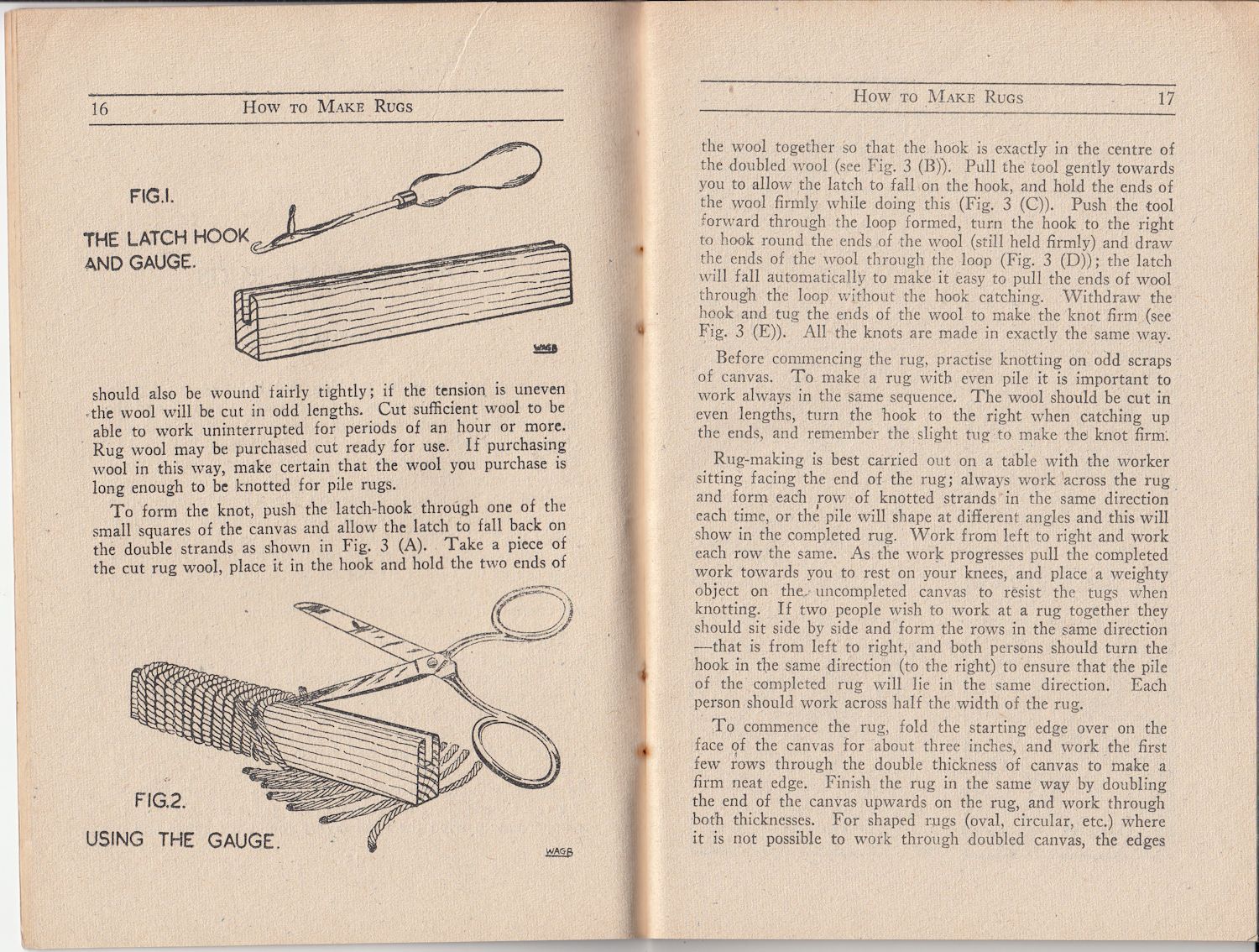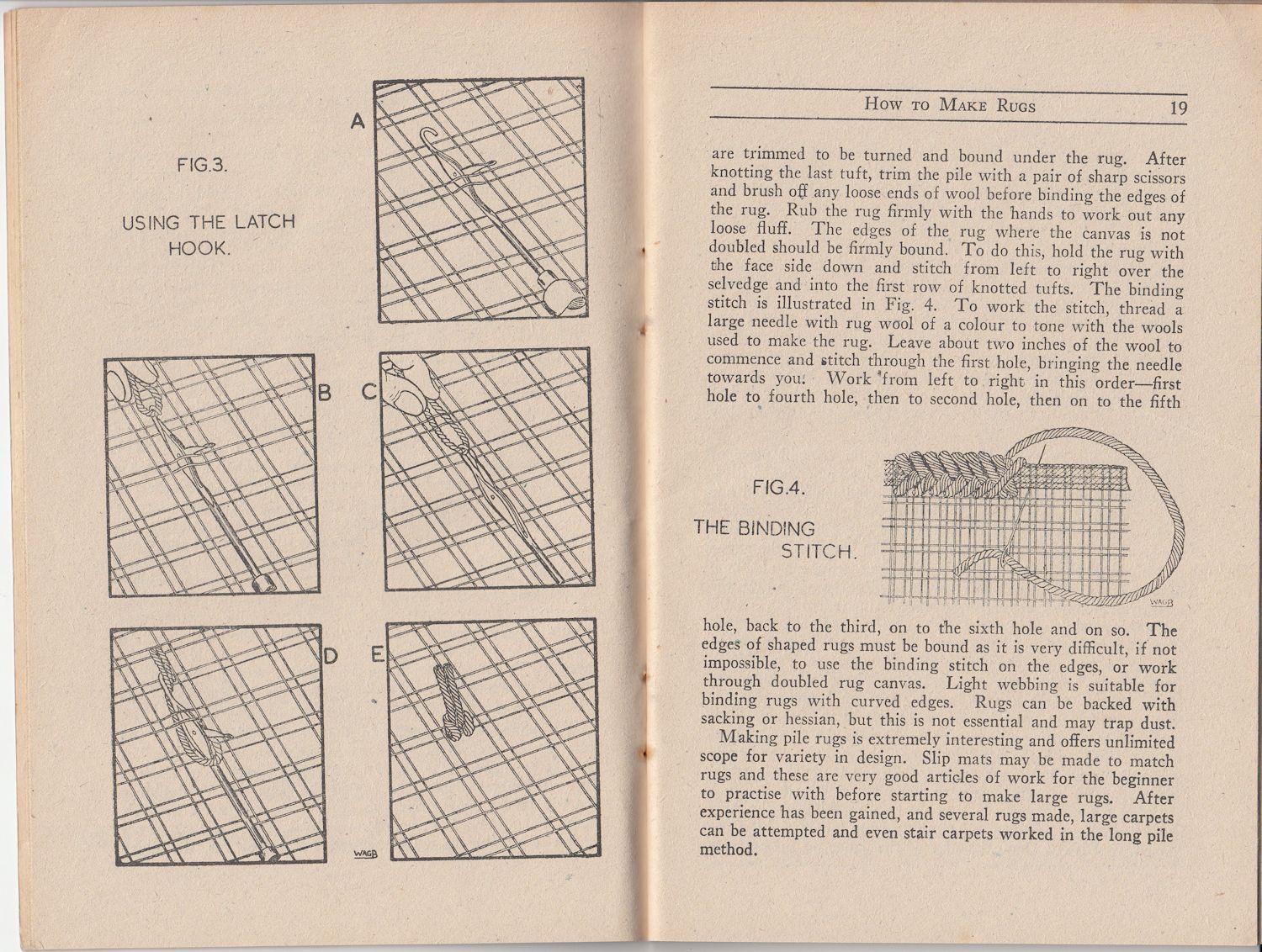
HOW TO MAKE RUGS (1950)
This little book was published by Bear Hudson (63 Goldhawk Road, London W12) in 1950 as a part of the "Books For The Home Craftworker" series available from Handicraft Stockists and Bookseller. As well as these pages of instructions for latch-hooking, it covers other methods of rug-making, from punch-needle to crochet and braiding.

HOW TO MAKE RUGS
Chapter I
Pile rugs are made by working and knotting cut lengths of wool on a foundation of rug canvas. This is one of the most popular methods of making rugs and is extremely simple. Only one special tool is required; the latch-hook illustrated in Fig. 1. A pair of sharp scissors are needed, and a razor blade may be found useful. The only piece of equipment required is a rug-making gauge (see Fig. 1). The foundation material is rug canvas, which may be obtained in various widths from 12 inches to 48 inches. The rug material is wool. It is preferable to use the proper rug wool, but ordinary knitting wool can be used if six strands are worked together. Sacking or hessian may be used to back the finished rug, but this is not essential if the edges are strongly bound.
The first thing about rug-making is to decide the shape and size of the rug, and then cut the canvas to suit. For square or rectangular rugs rt is advisable to purchase the canvas in the correct width required. The next thing is the design. This can be marked on the canvas or marked out on squared paper. Most rug canvases have squares marked on them to help in forming designs. The wool is cut in even lengths. This is done by winding the wool evenly around the full length of the gauge without overlapping, and cutting with the scissors or a razor blade along the groove in the gauge (see Fig. 2). It is important to wind the wool evenly round the gauge and it should also be wound fairly tightly; if the tension is uneven the wool will be cut in odd lengths. Cut sufficient wool to be able to work uninterrupted for periods of an hour or more. Rug wool may be purchased cut ready for use. If purchasing wool in this way, make certain that the wool you purchase is long enough to be knotted for pile rugs.

To form the knot, push the latch-hook through one of the small squares of the canvas and allow the latch to fall back on the double strands as shown in Fig. 3 (A). Take a piece of the cut rug wool, place it in the hook and hold the two ends of the wool together so that the hook is exactly in the centre of the doubled wool (see Fig. 3 (B)). Pull the tool gently towards you to allow the latch to fall on the hook, and hold the ends of the wool firmly while doing this (Fig. 3 (C). Push the tool forward through the loop formed, turn the hook to the right to hook round the ends of the wool (still held firmly) and draw the ends of the wool through the loop (Fig. 3 (D)); the latch will fall automatically to make it easy to pull the ends of wool through the loop without the hook catching. Withdraw the hook and tug the ends of the wool to make the knot firm (see Fig. 3 (E)). All the knots are made in exactly the same way.
Before commencing the rug, practise knotting on odd scraps of canvas. To make a rug with even pile it is important to work always in the same sequence. The wool should be cut in even lengths, turn the hook to the right when catching up the ends, and remember the slight tug to make the knot firm.
Rug-making is best carried out on a table with the worker sitting facing the end of the rug; always work across the rug and form each row of knotted strands in the same direction each time, or the pile will shape at different angles and this will show in the completed rug. Work from left to right and work each row the same. As the work progresses pull the completed work towards you to rest on your knees, and place a weighty object on the uncompleted canvas to resist the tugs when knotting. If two people wish to work at a rug together they should sit side by side and form the rows in the same direction - that is from left to right, and both persons should turn the hook in the same direction (to the right) to ensure that the pile of the completed rug will lie in the same direction. Each person should work across half the width of the rug.

To commence the rug, fold the starting edge over on the face of the canvas for about three inches, and work the first few rows through the double thickness of canvas to make a firm neat edge. Finish the rug in the same way by doubling the end of the canvas upwards on the rug, and work through both thicknesses. For shaped rugs (oval, circular, etc.) where it is not possible to work through doubled canvas, the edges are trimmed to be turned and bound under the rug. After knotting the last tuft, trim the pile with a pair of sharp scissors and brush off any loose ends of wool before binding the edges of the rug. Rub the rug firmly with the hands to work out any loose fluff. The edges of the rug where the canvas is not doubled should be firmly bound. To do this, hold the rug with the face side down and stitch from left to right over the selvedge and into the first row of knotted tufts. The binding stitch is illustrated in Fig. 4. To work the stitch, thread a large needle with rug wool of a colour to tone with the wools used to make the rug. Leave about two inches of the wool to commence and stitch through the first hole, bringing the needle towards you. Work from left to right in this order - first hole to fourth hole, then to second hole, then on to the fifth hole, back to the third, on to die sixth hole and on so. The edges of shaped rugs must be bound as it is very difficult, if not impossible, to use the binding stitch on the edges, or work through doubled rug canvas. Light webbing is suitable for binding rugs with curved edges. Rugs can be backed with sacking or hessian, but this is not essential and may trap dust.
Making pile rugs is extremely interesting and offers unlimited scope for variety in design. Slip mats may be made to match rugs and these are very good artic-les of work for the beginner to practise with before starting to make large rugs. After experience has been gained, and several rugs made, large carpets can be attempted and even stair carpets worked in the long pile method.
You are visitor number: